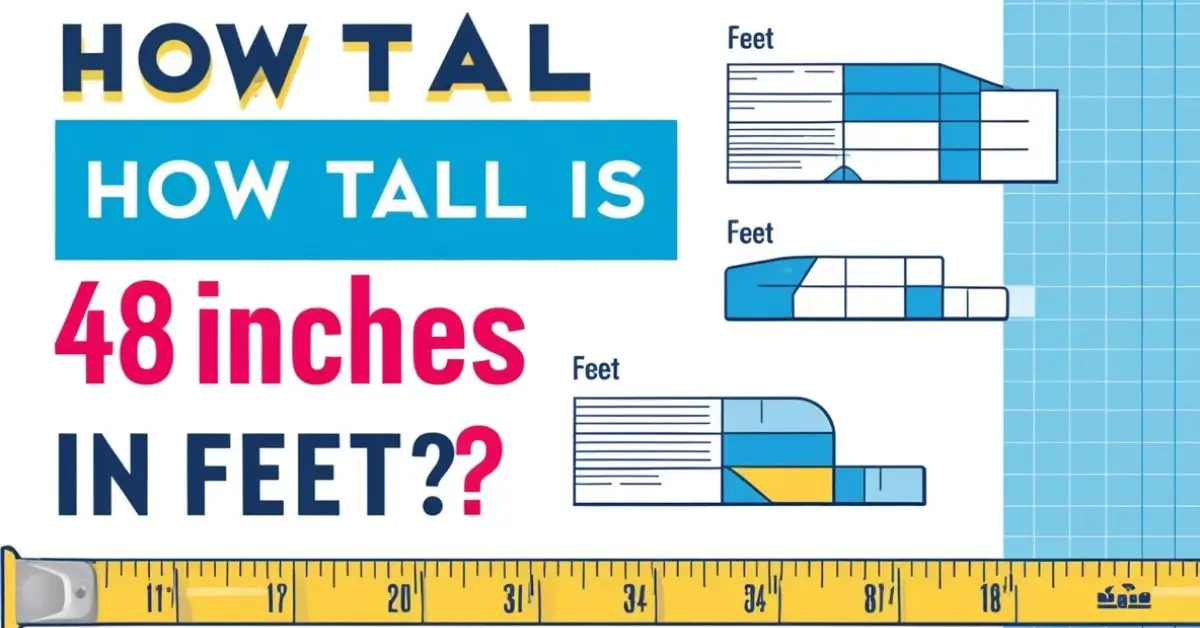When dealing with measurements, especially in countries that use the imperial system, you may often need to convert between inches and feet. Knowing these conversions can help you visualize dimensions more easily. One common question is: How tall is 48 inches in feet? The answer is straightforward—48 inches equals 4 feet. But let’s dive deeper to understand the calculation, comparisons, and real-world applications.
Converting Inches to Feet: The Basics
The imperial system defines one foot as 12 inches. Therefore, converting inches to feet involves dividing the total inches by 12. Using this simple formula:
48 inches ÷ 12 = 4 feet
This means that 48 inches is exactly 4 feet tall. Whether you’re measuring height, length, or depth, this conversion remains the same.
Why Understanding Measurements Matters
Measurements like 48 inches or 4 feet are frequently encountered in everyday situations. Knowing how to convert these helps in practical scenarios, such as:
- Furniture Dimensions: Understanding the height of tables, chairs, or countertops.
- Building Projects: Accurately measuring materials like wood or tiles.
- Personal Height: Comparing someone’s height in feet and inches.
Visualizing 48 Inches: Everyday Comparisons
To truly grasp how tall 48 inches is, it helps to relate it to familiar objects or scenarios. Here are some practical examples:
- A Kitchen Counter:
Most kitchen counters are about 36 inches (3 feet) tall. At 48 inches, we’re talking about an additional foot—taller than most countertops. - A Child’s Height:
The average height of a 7- to 8-year-old child is close to 48 inches. Imagine a young child standing next to you to get a sense of this measurement. - A Folding Table:
Many standard folding tables used at events are approximately 48 inches in length, providing a clear mental picture of this dimension.
Real-World Applications
Interior Design
If you’re furnishing a room, understanding dimensions is crucial. For instance, a decorative cabinet that stands 48 inches tall would be at a comfortable viewing height without overwhelming the room.
DIY Projects
When cutting materials like plywood or pipes, converting inches to feet ensures you get the right proportions. For example, knowing that 48 inches equals 4 feet allows you to plan better for a project requiring precise measurements.
Fitness Goals
Many people track their progress by height and weight. If someone is 48 inches tall, translating that to 4 feet can make it easier for doctors or trainers to communicate milestones or growth trends.
How to Teach Kids About Measurement
Helping children understand the relationship between inches and feet is a valuable skill. Here’s an activity idea:
- Grab a measuring tape and mark off 48 inches on the wall.
- Ask the child to count how many 12-inch segments fit into the 48 inches.
- Explain that each 12-inch section equals 1 foot.
This hands-on experience reinforces the concept and helps them visualize the relationship between inches and feet.
Comparison Chart: Inches to Feet
Here’s a quick reference chart for converting inches to feet:
| Inches | Feet |
|---|---|
| 12 | 1 |
| 24 | 2 |
| 36 | 3 |
| 48 | 4 |
| 60 | 5 |
| 72 | 6 |
| 84 | 7 |
| 96 | 8 |
| 108 | 9 |
| 120 | 10 |
Having this chart handy can make quick calculations a breeze.
Interesting Facts About Measurements
- Origins of Feet and Inches:
The imperial system has its roots in historical measurements. A “foot” was based on the average length of a human foot, while an inch was approximately the width of a thumb. - Global Use:
While the imperial system is mainly used in the United States, the metric system dominates globally. However, many people still find feet and inches easier to visualize. - Adaptability in Construction:
Even in countries using the metric system, builders and designers often use imperial measurements because of their long-standing use in architecture.
Practical Tips for Measurement Conversion
- Use Online Tools:
Measurement converters or calculator apps are great for quick results. - Remember Key Benchmarks:
Memorize key conversions, like 12 inches = 1 foot, 36 inches = 3 feet, and so on. It simplifies mental math. - Invest in a Dual-Scale Measuring Tape:
A tape measure with both imperial and metric units can save time and reduce errors.
Video Insight: Learn More About Conversions
Watching a video can make understanding these concepts easier. For example, a tutorial explaining how to measure objects or convert units can be a valuable resource. Search for measurement-related tutorials on platforms like YouTube for a visual guide.
Final Thoughts
Understanding that 48 inches equals 4 feet might seem like a small detail, but it has wide-ranging applications in daily life. Whether you’re arranging furniture, planning a construction project, or helping a child with their schoolwork, knowing this conversion is incredibly helpful.
The next time someone asks, “How tall is 48 inches in feet?” you’ll not only have the answer but also the context to explain it with confidence. Measurements are more than numbers—they’re tools that connect us to the world around us!












